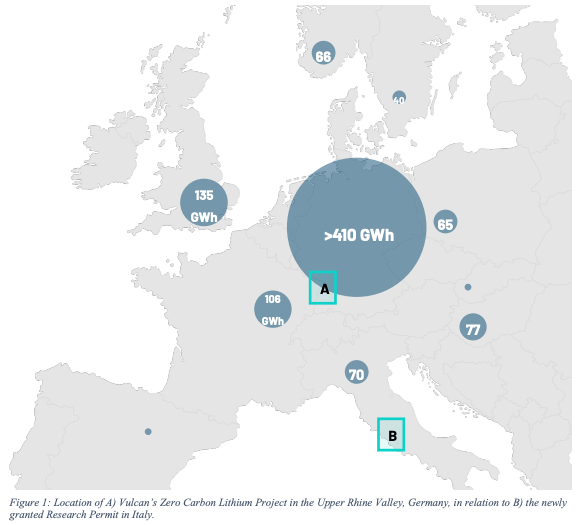ASX Green Energy Stocks: Vulcan may have found another source of geothermal lithium extraction, this time in Italy

VUL's new research permit is 20km north of Rome. Pic: Stefania Pelfini, La Waziya Photography via Getty
Vulcan’s (ASX:VUL) subsidiary, Vulcan Energy Italy, has been granted a new research permit in Italy named ‘Cesano’, 20km north-northwest of Rome, which holds the potential for sustainable lithium battery chemical development given the recorded high heat and lithium grades within the brine, and encouraging flow rates.
The company’s in-house geological team in Germany will collaborate with Italian geologists and local stakeholders to collate and assess historical data, verify the lithium content and assess the brine for potential lithium project development.
If successful, the Cesano Project could provide a source of strategic, sustainable lithium in Italy for Europe’s battery and automotive market and become a possible future additive to Vulcan’s Zero Carbon Lithium business.

VUL managing director Dr Francis Wedin said an extensive geological review had identified an area in Italy with positive flow rate, historical lithium grade and reservoir temperature indications.
“That could be conducive to Vulcan’s unique method of using renewable heat to drive lithium processing, with net zero carbon footprint, for the European electric vehicle market,” he said.
“We will be working with local partners to ascertain the potential of the area in more detail, and ascertain next steps.”
The research permit is located within the Cesano geothemeral field, discovered in 1974.
During 1975, a “hot brine” was discovered in a single geothermal well (Cesano 1) at a depth of approximately 1,390m below surface by ENEL.
Two hot brine samples yielded historical lithium contents of 350 and 380mg/L Li in filtered and unfiltered brine.
The historical results represent one of the highest global lithium grades recorded in a confined aquifer geothermal brine setting.
MoU signed with international solar company FRV
A series of hydrogen collaborations will be explored by Hexagon Energy (ASX:HXG) and international solar company, FRV Services Australia under a new memorandum of understanding.
The two entities have agreed to collaborate for a potential clean hydrogen hub at Middle Arm, Darwin in the Northern Territory, a new Northwestern Australian Hydrogen Hub development, and other collaborations elsewhere in Australia.
Immediate next steps will be to identify and scope specific hydrogen projects before moving to conditional heads of agreement and onto binding commercial agreements.
Both Hexagon and FRV Australia are already progressing individual clean hydrogen and renewable energy projects at or near Middle Arm, Darwin – each of which are fully funded in terms of pre-feasibility studies.
This collaboration could provide HXG access to FRV Australia’s mix of renewable energy products to supply the power required for Hexagon’s proposed hydrogen (clean ammonia) production plant.
It would see less CO2 generated from Hexagon’s blue hydrogen production facilities, requiring less CCS, therefore lowering overall production costs for Hexagon’s projects.
One step towards achieving large, scale commercial clean hydrogen production
While Hexagon is in the final stages of a pre-feasibility study on its Northern Territory Hydrogen Project, formally called Perdika, FRV Australia has secured funding for further studies and the construction stage for its hydrogen and renewable energy project.
For Hexagon, its project is targeting production of up to 1.6m tpa of ammonia or 300,000 tpa hydrogen equivalent.
The Middle Arm Sustainable Development Precinct at the Port of Darwin is expected to have several critical clean hydrogen project and hub components such as access to established, large scale CO2 geo-sequestration infrastructure and reservoirs (carbon capture and storage – CCS) and port (export) infrastructure.
HXG managing director Merrill Gray said this MoU underpins a potentially important step forward for the company in realising efficiencies and in improving the commercial viability for its base case decarbonised ammonia production plant.
“This MoU with FRV Australia is one of many important opportunities and collaborations, both in the NT and other locations,” he said.
“It will help to realise our objective in establishing the most practical pathway for Hexagon to achieve large scale, long term, commercial, clean hydrogen production in Australia.”
FRV Australia has successfully developed nine solar farms in Australia that are currently producing a combined total of 781MW of electricity sold into the National Electricity Market (NEM) and is currently developing additional projects within the Northern Territory.
These include its 29MW Berrimah Solar Farm where installation of an electrolyser is under assessment.
Calidus commits to renewable micro grid at Warrawoona
Calidus Resources (ASX:CAI) has entered into an agreement with Zenith Pacific for the construction of a 4MW solar farm with 3.5MW battery storage energy system as its Warrawoona Gold Project in WA’s East Pilbara region.
Zenith is currently constructing the 11MW gas-fired power station at Warrawoona under a Power Purchase Agreement (PPA) and the construction of the solar farm is part of the PPA whereby Calidus purchases power from Zenith.
At this stage, the solar farm will be constructed in the second half of 2022 to feed into the distribution line between the power station and accommodation village.
Calidus managing director Dave Reeves said the decision to proceed with the solar farm and battery storage was in line with the company’s Environmental, Social and Governance (ESG) initiatives.
“Calidus is committed to carbon reduction as part of its ESG policy,” he said.
“This renewable micro grid is a cornerstone to our carbon reduction plan which includes the use of LNG, not diesel, and the ability of the LNG gensets to use up to 25% hydrogen.”
Related Topics
UNLOCK INSIGHTS
Discover the untold stories of emerging ASX stocks.
Daily news and expert analysis, it's free to subscribe.
By proceeding, you confirm you understand that we handle personal information in accordance with our Privacy Policy.








